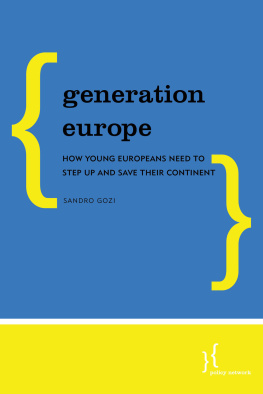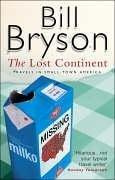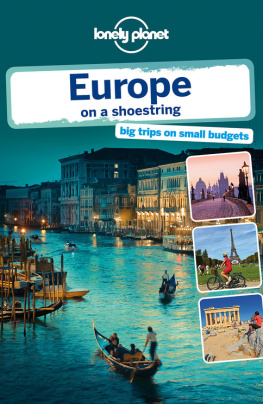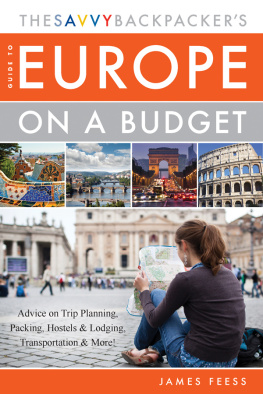The University of Chicago Press, Chicago 60637
The University of Chicago Press, Ltd., London
2017 by The University of Chicago
All rights reserved. No part of this book may be used or reproduced in any manner whatsoever without written permission, except in the case of brief quotations in critical articles and reviews. For more information, contact the University of Chicago Press, 1427 E. 60th St., Chicago, IL 60637.
Published 2017
Printed in the United States of America
26 25 24 23 22 21 20 19 18 17 1 2 3 4 5
ISBN-13: 978-0-226-43897-9 (cloth)
ISBN-13: 978-0-226-46203-5 (paper)
ISBN-13: 978-0-226-43902-0 (e-book)
DOI: 10.7208/chicago/9780226439020.001.0001
Library of Congress Cataloging-in-Publication Data
Names: Jobs, Richard Ivan, author.
Title: Backpack ambassadors: how youth travel integrated Europe / Richard Ivan Jobs.
Description: Chicago; London: The University of Chicago Press, 2017. | Includes bibliographical references and index.
Identifiers: LCCN 2016044002 | ISBN 9780226438979 (cloth: alk. paper) | ISBN 9780226462035 (pbk.: alk. paper) | ISBN 9780226439020 (e-book)
Subjects: LCSH: YouthTravelEuropeHistory. | International travelEuropeHistory20th century. | EuropeHistory1945
Classification: LCC G156.5.Y6 J63 2017 | DDC 914.04/550835dc23 LC record available at https://lccn.loc.gov/2016044002

This paper meets the requirements of ANSI/NISO Z39.481992 (Permanence of Paper).
Youth travel was both my inspiration and aspiration for this book. In 1997, I was a twenty-seven-year-old Rutgers University graduate student living in Paris, researching my dissertation. Two friends of mine with whom I had backpacked in India a couple of years earlier, Mark and Ari, visited me there. During their visit, the three of us took a trip to Amsterdam. This was actually my third time there. I had first visited Amsterdam as a Eurailing backpacker in the summer of 1990. While there with Mark and Ari, it occurred to me how much I liked the city, and how much I would like to spend some prolonged time there, as I was doing in Paris. That got me thinking about how I would like to spend time in lots of different places around Europe. I asked myself whether I could develop a research project that would enable that. While researching my book Riding the New Wave: Youth and the Rejuvenation of France after the Second World War (Stanford University Press, 2007), I discovered a variety of materials indicating that there was a significant social and cultural component to European integration, in addition to the straightforwardly economic and political elements, and that youth and young people were central to this project of international reconciliation from below.
For example, a series of studies from the mid-1990s pointed out that individual mobility was greatest among those between the ages of fifteen and twenty-four. In Europe, this age group accounted for a quarter of all cross-border traffic. An extraordinary fifty million young Europeans had traveled abroad, and another twenty million desired to do so. A fifth of all tourist journeys worldwide of European integration recognized and idealized the impact of transnational youth mobility on postwar Europe, they had contributed little institutional support to encourage or develop it.
Backpackers walking toward Central Station, Amsterdam, May 1973. Photograph by Rob Mieremet. National Archives of the Netherlands/Anefo, license by CC-BY.
The mass travel of young backpackers that began in Western Europe was a profoundly new phenomenon unique to the postwar period. This book is a history of youth travel in Europe, and how this cross-border mobility fostered a European social and cultural integration between the end of the Second World War and the end of the Cold War. The young, through their travels, transgressed politically constituted territories in ever-widening patterns. In doing so, they developed a transnational travel culture vital to the broad ideological trajectory of postwar Europe. Meanwhile, the practice of independent youth travel itself spread across borders, incorporating more and more young people from more and more places, reaching well beyond Europe and young Europeans. By studying the practice of travel by the young and the emergence of youth as a transnational social body in the postwar period, Backpack Ambassadors emphasizes a profoundly social and cultural integration, in addition to an economic and political one. By investigating the cultural practice of youth travel as a case study, it argues for a less EU-centric approach to the writing of European integration history. This book is not a history of the European Union or its antecedents. The development of youth travel worked at times with the institutional, technocratic efforts at formal integration, at times against them, and at other times outside them altogether. European integration is usually treated as a top-down affair, but this book is a cultural history that looks at the story from the bottom up, revealing how state policy and social activity interacted.
The postwar travel of the young between the various nations of Europe was intended to promote international cooperation and understanding. This would help the people of Western Europe avoid future violence and national aggression by developing an amicable familiarity with peoples and places. This project is integral to understanding the historical development of European integration by showing how Western European states and societies, through public-private partnerships, sought to surmount cultural divides and promote civic discourse through the international travel of the young. In the postwar period, the young of Western Europe were encouraged to interact and think of themselves as a transnational community based on age. Interestingly, the young individuals interconnecting Europe through circuitous travel were not exclusively European. Their geographic origins were increasingly diverse, ranging from North and South America to the Antipodes, Asia, and Africa. The policies of the United States government, and the activities of young Americans, Still, although their numbers were quite large, backpacking in Europe was not as much an American phenomenon as it was a European one.
Akira Iriye has led the way in considering the international relations of cultural organizations. The study of international relations has understandably operated in a paradigm that frames the national state as the key actor. Looking at the broad impact of transnational youth travel enables us to emphasize the horizontal dimensions of integration emerging from social activity, rather than just the vertical dimensions descending from the political activity of diplomats negotiating international treaties. While these backpackers were not ambassadorial in the sense of acting in the direct service of the state, their interactive mobility suggests a different kind of international relations.












 This paper meets the requirements of ANSI/NISO Z39.481992 (Permanence of Paper).
This paper meets the requirements of ANSI/NISO Z39.481992 (Permanence of Paper).
